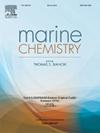Distribution, emission, and cycling processes of carbon monoxide in the tropical open ocean
IF 2.5
3区 地球科学
Q2 CHEMISTRY, MULTIDISCIPLINARY
引用次数: 0
Abstract
The carbon monoxide (CO) cycle in the marine mixed layer determines its emissions to the atmosphere and subsequently affects atmospheric chemistry and climate change. However, the contributions of oceanic CO transformation pathways and their impacting factors remain inadequately understood. Therefore, we investigated the distribution and cycle processes of CO in the Eastern Indian Ocean (EIO) and developed a CO budget model for the mixed layer. Surface seawater CO concentrations presented a diurnal variation due to periodic variations in solar radiation and rapid microbial consumption. The spatial distribution of CO in seawater was dominated by chromophoric dissolved organic matter (CDOM) and solar radiation. The EIO was a source of atmospheric CO and its daily CO emissions produced increases in the CO mixing ratio and hydroxyl radical consumption rate in the overlying atmosphere by 74.03 pptv and 6.48 pptv d−1, respectively. Additionally, the budget model findings indicated that photoproduction (CDOM plus particulate organic matter), dark production, and phytoplankton emission accounted for about 67 %, 30 %, and 3 % of total CO production. The microbial consumption (94 %) and sea-air exchange (6 %) were the primary and secondary sink for CO within the mixed layer, respectively. Moreover, the photo-mineralization of dissolved organic carbon was estimated using CO as a proxy for CO2 photoproduction. This study deepens our understanding of the oceanic CO cycle and the impact of photo-mineralization on the carbon cycle and is vital for refining global oceanic CO source-sink budgets and modelling studies.
一氧化碳在热带开阔海域的分布、排放和循环过程
海洋混合层中的一氧化碳(CO)循环决定了其向大气的排放,并随后影响大气化学和气候变化。然而,海洋CO转化途径的贡献及其影响因素仍未得到充分认识。因此,我们研究了东印度洋(EIO) CO的分布和循环过程,并建立了混合层CO收支模型。由于太阳辐射的周期性变化和微生物的快速消耗,表层海水CO浓度呈现日变化。海水中CO的空间分布以显色性溶解有机质(CDOM)和太阳辐射为主。EIO是大气CO的一个来源,其日CO排放使上覆大气CO混合比和羟基自由基消耗率分别增加了74.03 pptv和6.48 pptv d−1。此外,预算模型的结果表明,光合作用(CDOM加上颗粒物有机质)、暗产物和浮游植物排放约占总CO产量的67%、30%和3%。微生物消耗(94%)和海气交换(6%)分别是混合层CO的主要和次要汇。此外,利用CO作为CO2光生产的代表,估计了溶解有机碳的光矿化。这项研究加深了我们对海洋CO循环和光矿化对碳循环的影响的理解,对于完善全球海洋CO源汇预算和模拟研究至关重要。
本文章由计算机程序翻译,如有差异,请以英文原文为准。
求助全文
约1分钟内获得全文
求助全文
来源期刊

Marine Chemistry
化学-海洋学
CiteScore
6.00
自引率
3.30%
发文量
70
审稿时长
4.5 months
期刊介绍:
Marine Chemistry is an international medium for the publication of original studies and occasional reviews in the field of chemistry in the marine environment, with emphasis on the dynamic approach. The journal endeavours to cover all aspects, from chemical processes to theoretical and experimental work, and, by providing a central channel of communication, to speed the flow of information in this relatively new and rapidly expanding discipline.
 求助内容:
求助内容: 应助结果提醒方式:
应助结果提醒方式:


